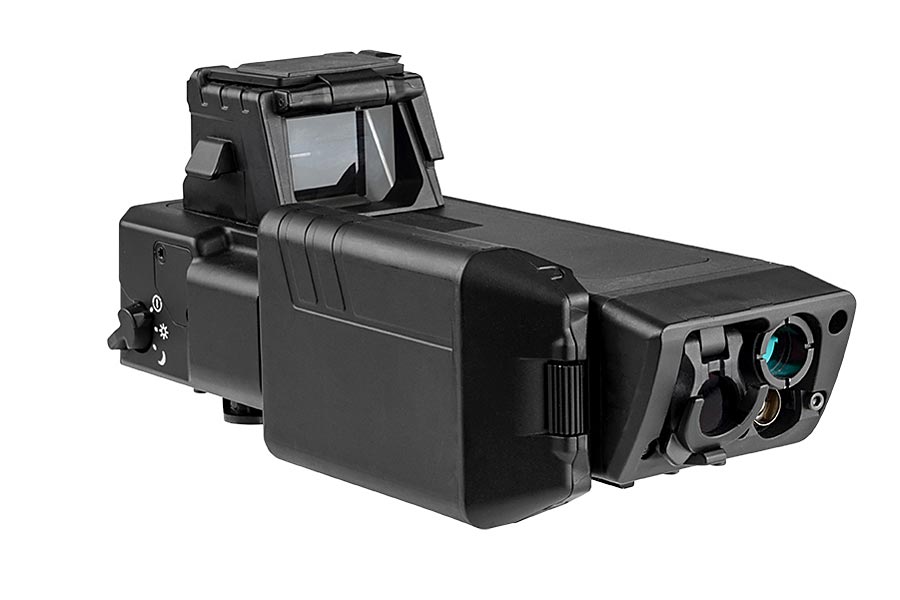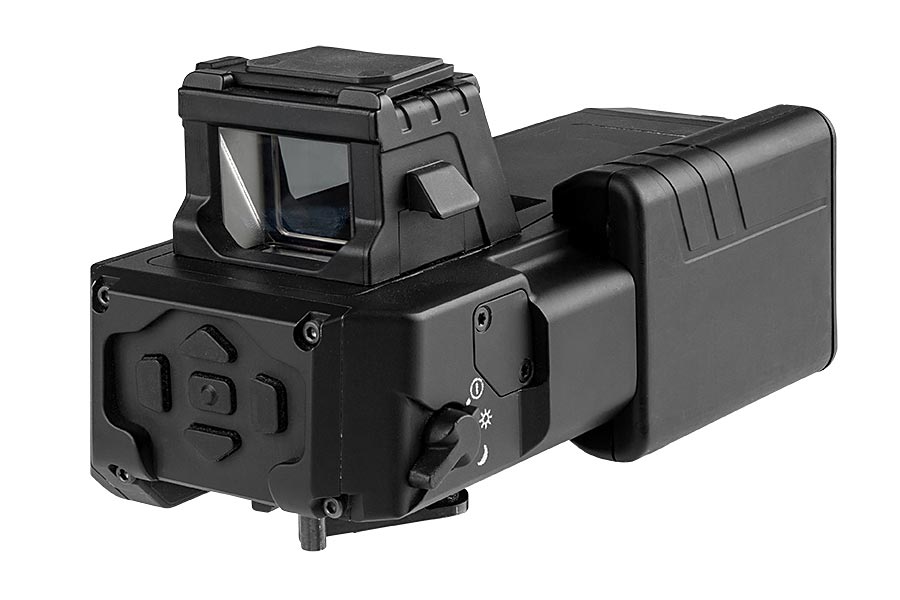SMASH 2000L Explained: The U.S. Army’s Latest Weapon Against Unmanned Aerial Threats
 |
| SMASH 2000L |
The recent integration of the SMASH 2000L Smart Fire Control System onto the assault rifle marks a pivotal advancement in modern infantry warfare. This cutting-edge technology, developed by Smart Shooter Ltd., is designed to provide soldiers with precision targeting against aerial threats, particularly small unmanned aerial systems (sUAS).
The Need for Advanced Counter-Drone Solutions
Drones have revolutionized warfare, offering reconnaissance, surveillance, and even offensive capabilities. However, their increasing accessibility has also made them a threat to ground forces. Traditional methods of countering drones often involve large-scale air defense systems, which may not be practical for individual soldiers in combat scenarios. The SMASH 2000L system addresses this gap by enabling dismounted troops to engage drones effectively using their standard rifles.
How the SMASH 2000L Works
The SMASH 2000L is a lightweight, electro-optical fire control system that attaches to an assault rifle. It utilizes AI-driven targeting algorithms to detect, track, and engage aerial threats with unmatched accuracy. The system scans for targets, locks onto them using computer vision, and calculates ballistic solutions in real time. Once the operator designates a target and applies trigger pressure, the SMASH system ensures the round is fired only when a direct hit is assured.
Deployment and Tactical Advantages
The U.S. Army awarded Smart Shooter Ltd. a $13 million contract in May 2025 for the procurement of SMASH 2000L systems under the Transformation In Contact (TIC 2.0) initiative. This initiative focuses on rapidly fielding next-generation technologies to frontline units. The SMASH 2000L was demonstrated during Project Flytrap at the Joint Multinational Readiness Center in Hohenfels, Germany, where soldiers showcased its effectiveness in live training exercises.
The integration of SMASH technology provides several tactical advantages:
Enhanced Accuracy: Eliminates human errors such as fatigue and stress, ensuring precise target engagement.
Compact and Lightweight: Easily mounted on standard rifles without adding excessive weight.
Versatile Targeting: Effective against both ground and aerial threats, making it a multi-purpose combat tool.
Real-Time Target Locking: AI-driven algorithms ensure optimal firing conditions, increasing the probability of a successful hit.
 |
| SMASH 2000L |
 |
| SMASH 2000L |
Future Implications
The deployment of SMASH 2000L signifies a paradigm shift in infantry warfare. As drone threats continue to evolve, AI-enabled fire control systems like SMASH will likely become standard equipment for modern soldiers. The success of this technology in counter-UAS operations could pave the way for further advancements in precision targeting and autonomous defense systems.
Expanding Counter-Drone Capabilities for Modern Warfare
As the battlefield becomes increasingly saturated with autonomous and remotely piloted aerial systems, the integration of AI-enhanced targeting technology like the SMASH 2000L highlights a growing need for real-time solutions. With adversaries employing drones for reconnaissance, intelligence gathering, and even offensive operations, the U.S. Army's strategy now prioritizes individual soldier capabilities alongside traditional air defense systems.
Training and Field Deployment
Adapting to new technology requires comprehensive training programs. Soldiers assigned to units receiving the SMASH 2000L Smart Fire Control System undergo specialized instruction in drone identification, target tracking, and fire control execution. The training emphasizes:
Recognizing aerial threats in various combat scenarios.
Maximizing system efficiency in urban, desert, and forest environments.
Integrating SMASH with traditional weapons handling techniques.
Moreover, battle simulations involving mock drone engagements test the effectiveness of the fire control system in real-time situations. These exercises serve to refine soldiers' response strategies, ensuring high hit probabilities against small and maneuvering targets.
SMASH 2000L vs. Conventional Methods
Historically, ground forces relied on machine guns, rifles, or improvised tactics to counter airborne threats. However, conventional targeting methods struggle against fast-moving drones due to:
Human reaction delay in assessing and tracking the target.
Limited precision with manual aiming and firing.
Reduced effectiveness against small or high-speed aerial threats.
The SMASH 2000L eliminates these challenges by providing automatic target acquisition, ensuring rounds are fired only at optimal moments. This drastically improves success rates, preventing wasted ammunition and reducing exposure to enemy threats.
Potential Future Developments
As AI and autonomous defense technology advance, fire control systems like SMASH will likely see new enhancements, including:
Integration with wearable heads-up displays (HUDs) for streamlined targeting data.
Automated threat assessment features to classify and prioritize enemy drones.
The battlefield of the future will undoubtedly rely on AI-driven targeting and automated precision weaponry. The successful deployment of SMASH 2000L is expected to influence the development of next-generation infantry technology across multiple military branches.
Advantages and Disadvantages of the SMASH 2000L Smart Fire Control System
Advantages
The SMASH 2000L provides several key benefits that enhance infantry operations, particularly in counter-drone warfare:
Precision Targeting – The AI-driven fire control system ensures high accuracy, allowing soldiers to engage fast-moving aerial threats with minimal ammunition wastage.
Reduced Human Error – By automating target acquisition and firing logic, fatigue, stress, and manual aiming inaccuracies are significantly reduced.
Enhanced Soldier Protection – The ability to neutralize hostile drones quickly minimizes the risk of enemy surveillance, reconnaissance, and aerial attacks.
Lightweight and Portable – Unlike traditional anti-air defense systems, SMASH 2000L mounts directly onto a standard rifle without adding excessive bulk, making it ideal for dismounted troops.
Multi-Purpose Use – While primarily designed for counter-drone operations, the system can also enhance targeting precision against human and vehicle threats, making it a versatile battlefield tool.
Real-Time Engagement – The on-the-fly tracking capability allows soldiers to engage aerial threats dynamically, without needing separate specialized hardware.
Cost-Effective Solution – Compared to large-scale air defense systems, deploying individual SMASH units is a more affordable and scalable approach to countering drones across multiple military units.
Disadvantages
Despite its advantages, the SMASH 2000L has limitations that must be considered:
1. Vulnerability Against Swarm Drone Attacks
Swarm drones—multiple drones operating in coordinated formations—pose a unique challenge. The SMASH 2000L is designed for single-target engagement, meaning:
It may struggle to track and neutralize multiple drones simultaneously.
Soldiers using the system could be overwhelmed by a large swarm, reducing effectiveness.
Swarm drones often employ evasive maneuvers, making it difficult for AI-assisted targeting to lock onto multiple threats at once.
2. Limited Range Against High-Altitude UAVs
The SMASH 2000L is optimized for short-to-medium-range engagements, typically within 170 meters. However:
High-altitude drones flying above infantry engagement zones remain out of reach.
Larger UAVs used for surveillance or airstrikes require long-range countermeasures, such as missile systems or electronic warfare.
3. Dependence on Optical Sensors and AI Algorithms
The SMASH 2000L relies on computer vision and AI-driven tracking, which introduces potential weaknesses:
Environmental factors like fog, smoke, or poor lighting can reduce accuracy.
Electronic interference or jamming technology could disrupt target acquisition, rendering the system ineffective.
AI limitations may struggle with rapidly changing battlefield conditions, such as unexpected drone movements or complex terrain.
4. Requires Specialized Training
Soldiers must undergo dedicated training programs to effectively integrate the system into combat scenarios, which may slow immediate deployment.
5. Not a Standalone Defense System
Despite its effectiveness, SMASH 2000L works best as part of a larger defense strategy, including radar tracking, missile systems, and electronic warfare.
The SMASH 2000L Smart Fire Control System represents a revolutionary advancement in soldier-based counter-drone warfare, offering precision, portability, and ease of use. However, as with any technology, its limitations must be mitigated through proper training, ongoing development, and complementary defense strategies.
Specifications of the SMASH 2000L Smart Fire Control System:
Weight: Approximately 740g (sight only).
Dimensions: 164mm x 73.5mm x 75mm.
Power Source: Rechargeable smart Lithium-Ion battery pack, providing up to 72 hours of operation or 3,600 SMASH-assisted shots.
Targeting System: AI-driven target acquisition and tracking, ensuring precise engagement against aerial and ground threats.
Optics: See-through reflex sight, allowing both eyes open shooting for enhanced situational awareness.
Ballistic Support: Compatible with a wide variety of ammunition types, dynamically adjusting for optimal firing conditions.
Connectivity: Integration with C4I systems, enabling real-time battlefield data synchronization.
Environmental Resistance: MIL-STD-810G and MIL-STD-461E compliant, ensuring durability in harsh combat conditions.
Weapon Compatibility: Mounts on standard weapon rails, allowing integration with M4, AR-15, SR25 (M110), and other rifles.
Operational Modes: Includes Lock & Track, Dynamic Firing Zone, and Swift Mode Change for adaptability in combat scenarios.
The U.S. Army's adoption of the SMASH 2000L Smart Fire Control System represents a major leap in counter-drone warfare. By equipping soldiers with AI-driven targeting capabilities, the military is ensuring that frontline troops remain effective and protected against emerging aerial threats. As warfare continues to evolve, innovations like SMASH 2000L will play a crucial role in shaping the future of combat strategy and defense technology.
The introduction of SMASH 2000L into the U.S. Army’s arsenal signifies a proactive stance in modern warfare adaptation. By ensuring soldiers can effectively counter hostile drones, the military strengthens its combat survivability and operational effectiveness. As drone warfare continues to evolve, fire control technology advancements like SMASH provide a critical edge on the battlefield, shaping the future of infantry combat and defense strategy.





